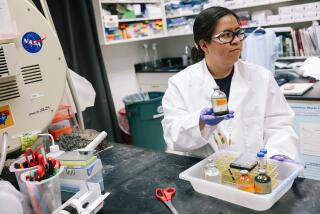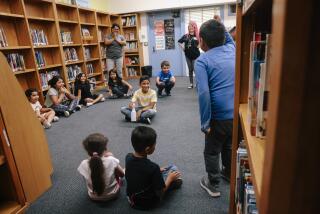Students in Orbit Over Summer Jobs at JPL
- Share via
Some students earn summer spending money by flipping burgers, others by soaping down dirty cars or pushing mowers across neighborhood lawns.
But some earn their money plotting trajectories for spacecraft to intercept Halley’s comet, testing parts for the Venus Radar Mapper or handling $1-million X-band downconverters.
These are the whiz kids of the Jet Propulsion Laboratory in La Canada Flintridge. Recent high school graduates and college students, they are smart and lucky enough to have landed coveted jobs at the National Aeronautics and Space Administration installation, where their endeavors aid spacecraft exploration of the solar system.
The 225 students in a variety of programs at JPL this summer were selected from about 2,000 applicants. With that competition, it is clear they have more than just a demonstrated knack for things electronic, technological and mathematical.
“I don’t understand what they do here, but I think it’s fascinating,” said Valerie Bailey, JPL’s recruitment supervisor, who is not a scientist.
The teen-agers hired are all considered good prospects in the science and engineering job market. For JPL, hiring them to work summers now is an investment that may pay off after they
graduate from college. “We like to grow some of our own,” Bailey said. The students are paid $4.50 to $5.50 an hour.
During the last 20 years, JPL has worked on many technical aspects of nearly all the U.S. space missions, including the Mariner series that explored Mars, Venus and Mercury, the Viking Mars Orbiters and the Voyager missions to Jupiter and Saturn. About 75% of the students actually work on such technical matters, with the rest in clerical and other support jobs helping JPL’s nearly 5,000 employees.
For example, Kenneth Berryman, a Harvard-bound 1985graduate of La Canada High School, is working in the orbital mechanics division. After reading a couple of books on the subject, he said, he is “playing around with” plotting a trajectory for spacecraft to intercept Halley’s comet.
The 17-year-old aspiring astrophysicist recently returned from Washington and a reception with President Reagan, where he was honored as one of the two Presidential Scholars named this year from California.
Peter Breckheimer, Berryman’s supervisor, said he has been impressed with the youth’s job performance.
“He has advanced math capabilities and understanding of physics, a lot of which is self-taught,” Breckheimer said. “He is a very motivated young man.”
Alfred Burress is working at JPL in the Summer Hire Program after working the previous two summers at JPL under the U.S. Department of Education’s Upward Bound program for economically deprived youngsters.
The 18-year-old Pomona High graduate has been spending his summer testing spacecraft electronic subsystems, which suits him fine, since he is going to study electronic engineering at Southern University in Louisiana this fall.
Jump on Others
Burress said the work experience has given him the feeling that he can leave for school already knowing a little bit about what he is going to be taught.
“I can get a little jump ahead of the people who are at home doing nothing this summer,” said Burress, who played basketball for Pomona High, where he was the senior class president.
Patricia Gomez will enter USC in the fall, and her summer job at JPL is the first she has ever had. More than a third of JPL’s summer employees are women.
Gomez is taking inventory of the parts of a piece of telecommunications equipment of the Venus Radar Mapper, which is set for a mission to Venus and Mars in the late ‘80s and early ‘90s.
Called an X-band downconverter, the equipment is an electronics-stuffed, 6-by-3-inch metallic box that represents 2 1/2 years’ work by the engineers in her section and cost nearly $1 million.
Example for Family
Gomez, 17, said she has never considered herself an example of the increasing number of women entering technical fields, but nevertheless is being held up as a sort of example in her family.
“My aunt is always telling my 12-year-old cousin, ‘See, if you study your math and science real hard you can do that too,’ ” she said.
A June graduate of Woodrow Wilson High in Los Angeles, Gomez said she was told about the summer program by a high school counselor.
JPL recruiters visit 33 colleges across the country during the school year in search of future top-flight engineers and scientists, and have an extensive network of contacts in Southern California colleges and high schools. Besides the 25 college professors who work part time at JPL, the firm hires for the summer program about 20 local high school math, science and business teachers. This summer, there are three from Hoover High in Glendale and two from La Canada High.
Tips From Teachers
“We get quite a few student hires through the teachers,” Bailey said. “They let us know who is red-hot.”
Summer workers who prove exceptional are usually offered part-time employment during the academic year, with an eye toward hiring them full time when they finish school, JPL officials said. JPL has in some cases maintained this link with students all the way through their doctoral studies.
Stephen McNally, an 18-year-old who had been trying to get a job at JPL since he was a sophomore in high school, finally was selected for JPL’s program this summer. He spent last summer working at a more typical teen-age job as a busboy in a coffee shop.
McNally, a recent graduate of William S. Hart High in Newhall, is programming computers in JPL’s communications department. He is entering Caltech in the fall to study aeronautical engineering.
“Eventually, I would like to design a few spacecraft of my own,” he said. “I’ve always been interested in anything to do with space.”
More to Read
Sign up for Essential California
The most important California stories and recommendations in your inbox every morning.
You may occasionally receive promotional content from the Los Angeles Times.










